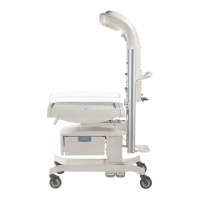Appendix D: Troubleshooting
Service Mode (Application Software 1.0.9 and Earlier)
D-6 Service Manual
“SILENCE” Byte 0 – Indicates the alarm that has been silenced.
This byte can be cross-referenced to Appendix C by adding 1.
IF Byte 0 = 9 then this indicated Alarm 10 on the table Temp. Probe Failure.
Byte 1 – The stage of the alarm. A “1” indicates the alarm has just occurred. A “2” indicates the alarm has
progressed because the alarm condition has not been alleviated or the alarm has not been silenced.
“SYSFAIL” Bytes 0-3 – The auxiliary data associated with the system failure.
Byte 4 – The system failure number which corresponds to the values found in the tables in section 4.4.5.
“STATE” Bytes 0-3 – The patient set point listed in hexadecimal byte-swapped format.
Note: No decimal place is present (6d 01 00 00 can be looked at as 0x0000016d which translates to 365 or
36.5 degrees C).
Byte 4 – Is used internally to determine what menu is on the screen.
Byte 5 – Is an indication of the mode.
“0x11” for Manual Mode.
“0x12” for Baby Mode.
“0x13” for Preheat Mode.
Byte 6 – Is an indication of the SpO
2
State.
“0” is not present.
“1” is present, but never attached to a patient.
“2” is no probe connected.
“3” is running.
“4” is stopped.
“5” is out of service.
Byte 7 – Is a hexadecimal indication of the percent power (from 0% to 100%).
“CFG” Byte 0 – Temp Units (0 for Centigrade, 1 for Fahrenheit).
Byte 1 – Alarm Volume.
Byte 2 – Elevating Base (0 for disabled, 1 for enabled).
Byte 3 – Hands Free Silence (0 for disabled, 1 for enabled).
Byte 4 – Patient Temp Alarm Setting.

